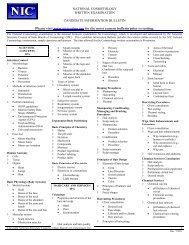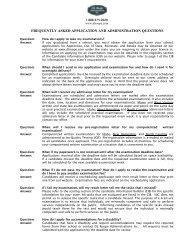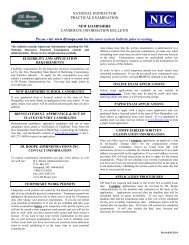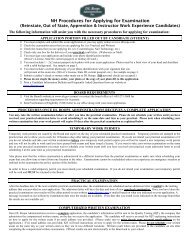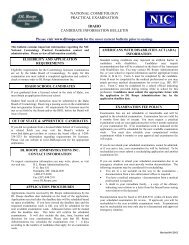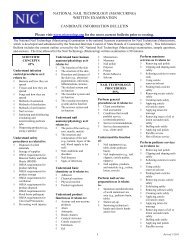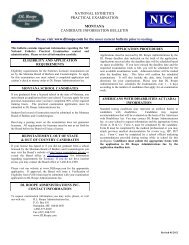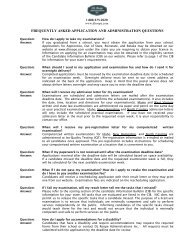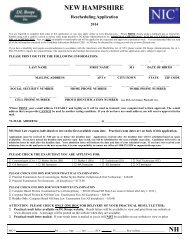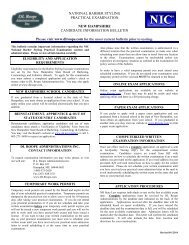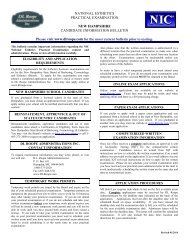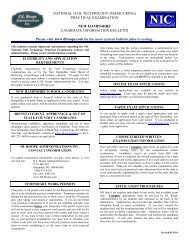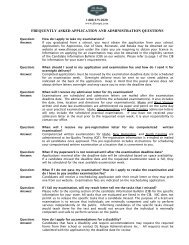Download PDF - National-Interstate Council of State Boards of ...
Download PDF - National-Interstate Council of State Boards of ...
Download PDF - National-Interstate Council of State Boards of ...
You also want an ePaper? Increase the reach of your titles
YUMPU automatically turns print PDFs into web optimized ePapers that Google loves.
NATIONAL ELECTROLOGY<br />
WRITTEN EXAMINATION<br />
CANDIDATE INFORMATION BULLETIN<br />
Please visit www.nictesting.org for the most current bulletin prior to testing.<br />
The <strong>National</strong> Electrology examination is the national licensure examination for Electrologists, which is developed and administered by the<br />
<strong>National</strong>-<strong>Interstate</strong> <strong>Council</strong> <strong>of</strong> <strong>State</strong> <strong>Boards</strong> <strong>of</strong> Cosmetology (NIC). This Candidate Information Bulletin includes the content outline covered<br />
by the NIC <strong>National</strong> Electrology examination. The time allowed for the Electrology written examination is 90 minutes.<br />
SCIENTIFIC<br />
CONCEPTS<br />
65%<br />
Infection Control<br />
◊ Microbiology<br />
◊<br />
◊<br />
◊<br />
• Bacteria<br />
• Viruses<br />
• Fungi<br />
• Parasites<br />
Methods <strong>of</strong> infection<br />
control<br />
• Heat<br />
• Chemical agents<br />
• Ultraviolet<br />
Levels <strong>of</strong> infection control<br />
• Sanitation<br />
• Disinfection<br />
• Sterilization<br />
Safety procedures<br />
• Center for Disease<br />
Control (CDC)<br />
• OSHA standards<br />
• Chemicals (labeling,<br />
mixing, storage)<br />
Basic Concepts <strong>of</strong> Electricity<br />
◊ Characteristics <strong>of</strong><br />
electricity and electrical<br />
measurement<br />
◊ Types<br />
◊<br />
• Direct currents<br />
• Alternating currents<br />
Modalities <strong>of</strong> Electrolysis<br />
• Galvanic<br />
• Thermolysis<br />
• Blend<br />
Basic Chemistry<br />
◊ Organic and inorganic<br />
matter<br />
◊ Elements, compounds, and<br />
mixtures<br />
◊ Acidity/alkalinity (pH)<br />
◊ Effect <strong>of</strong> galvanic action<br />
Human Physiology and<br />
Anatomy<br />
◊ Cells<br />
◊ Tissues<br />
◊ Organs<br />
◊ Systems and their<br />
functions<br />
◊ Understand skin histology<br />
◊<br />
◊<br />
• Layers <strong>of</strong> the skin<br />
• Structures <strong>of</strong> the skin<br />
• Functions <strong>of</strong> the skin<br />
Diseases and disorders <strong>of</strong><br />
the skin<br />
• Primary lesions<br />
• Secondary lesions<br />
• Sebaceous disorders<br />
• Sudoriferous<br />
disorders<br />
• Pigmentation<br />
• Inflammation<br />
• Hypertrophies<br />
Hair and its growth cycle<br />
• Hair structure<br />
• Hair types<br />
• Hair growth cycles<br />
• Regrowth<br />
• Excessive hair<br />
growth<br />
Consultation<br />
◊<br />
◊<br />
◊<br />
◊<br />
◊<br />
SERVICES<br />
35%<br />
Confidentiality<br />
Previous treatments<br />
Explanation <strong>of</strong> treatment<br />
• Possible effects from<br />
treatment<br />
• Expected result <strong>of</strong><br />
treatment<br />
• Grounded plugs<br />
Effects <strong>of</strong> temporary hair<br />
removal<br />
• Physical<br />
• Chemical (i.e.<br />
depilatory)<br />
After-care/home care<br />
Client Record Keeping<br />
◊ Medical history<br />
• Conditions<br />
• Contraindications<br />
• Medications<br />
◊ Record <strong>of</strong> treatment<br />
• Modality used<br />
• Machine settings<br />
• Treatment area<br />
• Size and type <strong>of</strong><br />
needle/probe<br />
• Products used<br />
Safe Practices<br />
◊ Equipment & supplies<br />
◊<br />
◊<br />
◊<br />
◊<br />
• Equipment operation<br />
and maintenance<br />
• Safety procedures<br />
• Types <strong>of</strong> machines<br />
• Use and care <strong>of</strong><br />
needles/probes<br />
• Disposable supplies<br />
Client Protection<br />
• Draping procedures<br />
• Eye protection<br />
• Maltreatment<br />
Positioning<br />
• Client<br />
• Electrologist<br />
Selection <strong>of</strong> needle or<br />
probe<br />
• Skin type<br />
• Hair type<br />
Insertion <strong>of</strong> needle/probe<br />
• Angle<br />
• Depth<br />
Treatment Selection<br />
◊ Electrolysis<br />
◊ Thermolysis<br />
◊ Blend<br />
SAMPLE QUESTIONS<br />
The following sample<br />
questions are similar to those<br />
on the NIC Electrology<br />
Written Examination. Each<br />
question is followed by four<br />
answer choices. Only one<br />
choice is correct. Correct<br />
answers are listed following the<br />
sample questions.<br />
1. Disease producing<br />
bacteria are called<br />
a. hyperemia.<br />
b. pathogenic.<br />
c. hypo-allergenic.<br />
d. non-pathogenic.<br />
2. Which <strong>of</strong> the following<br />
would result in the<br />
GREATEST production <strong>of</strong><br />
lye?<br />
a. Increase both current<br />
and time<br />
b. Decrease both current<br />
and time<br />
c. Increase current and<br />
decrease time<br />
d. Decrease current and<br />
increase time<br />
3. Hair grows from the papilla<br />
by multiplication <strong>of</strong> the<br />
a. matrix cells.<br />
b. stratum lucidum.<br />
c. papillary layer.<br />
d. reticular region.<br />
4. What temporary method <strong>of</strong><br />
hair removal accelerates the<br />
shedding <strong>of</strong> the horny layer<br />
<strong>of</strong> the skin?<br />
a. Bleaching<br />
b. Depilatory<br />
c. Threading<br />
d. Clipping<br />
Copyright <strong>National</strong>-<strong>Interstate</strong> <strong>Council</strong> <strong>of</strong> <strong>State</strong> <strong>Boards</strong> <strong>of</strong> Cosmetology, Inc. | 1<br />
Revised 7/2011
NIC ELECTROLOGY WRITTEN EXAMINATION CANDIDATE INFORMATION BULLETIN<br />
5. Electrolysis is recognized<br />
as the only proven method<br />
<strong>of</strong> permanent hair removal<br />
by the<br />
a. Environmental Protection<br />
Agency (EPA).<br />
b. Food and Drug<br />
Administration (FDA).<br />
c. Centers for Disease<br />
Control (CDC).<br />
d. Occupational Safety and<br />
Health Administration<br />
(OSHA)<br />
Answers<br />
1. b 4. b<br />
2. a 5. b<br />
3. a<br />
ELECTROLOGY<br />
REFERENCES<br />
Milady's Hair Removal<br />
Techniques: A Comprehensive<br />
Manual, 2004, Bickmore,<br />
Helen, R.,<br />
Milady<br />
5 Maxwell Drive<br />
Clifton Park, NY 12065<br />
(800) 730-2214<br />
www.Milady.com<br />
Electrolysis, Thermolysis, and<br />
the Blend<br />
The Principles and Practices <strong>of</strong><br />
Permanent Hair Removal,<br />
9 th ed., 1994<br />
Arroway Publishing<br />
Modern Electrology: Excess<br />
Hair, Its Causes and<br />
Treatments, 1987<br />
Milady<br />
5 Maxwell Drive<br />
Clifton Park, NY 12065<br />
(800) 730-2214<br />
www.Milady.com<br />
Cosmetic and Medical<br />
Electrolysis and Temporary<br />
Hair Removal<br />
A Practice Manual and<br />
Reference Guide, 2 nd Ed., 1997<br />
Medric Ltd.<br />
Toronto, Ontario<br />
(416) 590-9842<br />
Infection Control Standards for<br />
the Practice <strong>of</strong> Electrology<br />
American Electrology Association<br />
OPTIONAL<br />
REFERENCES<br />
NIC Health and Safety<br />
Standards<br />
NIC, Inc., October 2002<br />
www.nictesting.org<br />
Copyright <strong>National</strong>-<strong>Interstate</strong> <strong>Council</strong> <strong>of</strong> <strong>State</strong> <strong>Boards</strong> <strong>of</strong> Cosmetology, Inc. | 2<br />
Revised 7/2011



